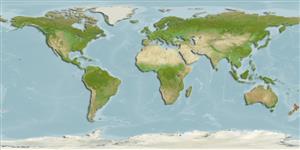Environment: milieu / climate zone / depth range / distribution range
Ecología
marino asociado a arrecife; rango de profundidad 1 - 50 m (Ref. 13227). Temperate
Southwest Pacific: around mainland New Zealand.
Tamaño / Peso / Age
Maturity: Lm ? range ? - ? cm
Max length : 5.9 cm SL macho / no sexado; (Ref. 13227)
Short description
Morfología | Morfometría
Espinas dorsales (total): 24 - 29; Radios blandos dorsales (total): 12-15; Espinas anales 0-1; Radios blandos anales: 24 - 27; Vértebra: 42 - 46. Body elongated, laterally compressed posteriorly; mouth strongly angled upward; notched scales absent; short, distally complex gill rakers, body yellow with a broad, black stripe extending along upper side of body. Discontinuous lateral line with 16-22 tubular scales. Anterior 2 spines of first dorsal fin shorter than remainder, which are of equal length. No sensory papillae on frontal, temporal and upper part of otic areas. Post-temporal partially serrated. Dorsal fin formula V-0N-0-1-0-1. Ten procurrent rays in both upper and lower caudal lobes; in the upper lobe, 1 procurrent ray between upper lobe and posterior epural, 3 rays opposite posterior epural, 1 ray between posterior and anterior epurals. Two opposite anterior epural, 1 opposite neural spine of second preural vertebra; in lower lobe, 3 rays opposite haemal spine of second preural vertebra, 4 rays between haemal spines of second and third preural vertebra, 2 rays opposite haemal spine of third preural vertebra and 1 anterior haemal spine of third preural vertebra.
Facultative air-breathing in the genus (Ref. 126274); Adults are found over rocky reefs at depths of 1- 50 m (Ref. 13227) and usually seen schooling up to 5 m above substratum, although often seen resting in crevices (Ref. 84085).
Life cycle and mating behavior
Madurez | Reproducción | Puesta | Huevos | Fecundidad | Larva
Fricke, R., 1994. Tripterygiid fishes of Australia, New Zealand and the southwest Pacific Ocean (Teleostei). Theses Zool. 24:1-585. (Ref. 13227)
IUCN Red List Status (Ref. 130435)
Threat to humans
Harmless
Human uses
Pesquerías: sin interés
Más información
ReferenciasAcuiculturaPerfil de acuiculturaRazasGenéticaElectrophoresesheritabilidadEnfermedadesProcesamientoNutrientsMass conversion
ColaboradoresImágenesStamps, Coins Misc.SonidosCiguateraVelocidadTipo de nataciónSuperficie branquialOtolitosCerebrosVisión
Herramientas
Special reports
Download XML
Fuentes de Internet
Estimates based on models
Preferred temperature (Ref.
123201): 14.4 - 16.6, mean 16 °C (based on 26 cells).
Phylogenetic diversity index (Ref.
82804): PD
50 = 0.5039 [Uniqueness, from 0.5 = low to 2.0 = high].
Bayesian length-weight: a=0.00562 (0.00300 - 0.01053), b=3.11 (2.94 - 3.28), in cm total length, based on LWR estimates for this species & (Sub)family-body (Ref.
93245).
Nivel trófico (Ref.
69278): 3.3 ±0.4 se; based on size and trophs of closest relatives
Resiliencia (Ref.
120179): Alto, población duplicada en un tiempo mínimo inferior a 15 meses (Preliminary K or Fecundity.).
Fishing Vulnerability (Ref.
59153): Low vulnerability (10 of 100).
Nutrients (Ref.
124155): Calcium = 88.7 [34.8, 227.5] mg/100g; Iron = 0.501 [0.205, 1.064] mg/100g; Protein = 18.6 [17.1, 20.0] %; Omega3 = 0.297 [0.108, 0.818] g/100g; Selenium = 10.1 [3.1, 31.5] μg/100g; VitaminA = 46.1 [7.6, 252.7] μg/100g; Zinc = 1.49 [0.80, 2.70] mg/100g (wet weight);
